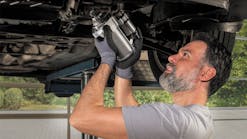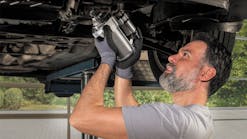As drivers across the country turn on the air conditioning (A/C) for the first time this year, vehicle repair shops are getting busy servicing these systems.
Over the years, there have been many new technologies introduced for air conditioning that technicians need to be aware of, according to Peter McArdle from Four Seasons, an aftermarket climate control parts supplier, speaking at ToolTech 2021 on Monday. The hybrid event included virtual sessions as well as in-person functions in Austin, Texas, and is put on by the Equipment and Tool Institute (ETI).
1. Half the charge, double the efficiency
Due to the climate crisis, manufacturers have been required to be more efficient with their oil charge and they have significantly reduced the amount of oil used in the A/C system. Before, 7 oz. of oil was used, and now 4 oz. is the norm.
“With less oil, getting lubrication right is much more critical on modern AC systems,” McArdle said. “Understand exact refrigerant and oil charge amounts are critical when you are repairing an A/C system.”
2. Compressor mix has changed
Nowadays, there are significantly more electronically controlled variable displacement (ECV) compressors in vehicles, which can increase complexity.
“Traditional repair techniques that worked 20 years ago might not work as well today,” McArdle said.
Previously, the compressors were controlled internally, but now with the ECVs, they are controlled externally by a computer.
The distinction also needs to be made between ECVs with a clutch and those that are clutchless.
To diagnose a problem with a compressor, you can use a scan tool or a dedicated tool, McArdle said.
3. TSB19C compressor technology
The TSB19C is a newer technology that measures the volume of the amount of refrigerant passing through the compressor. As the refrigerant volume flow increases, the voltage goes down.
“It’s all about achieving absolute efficiency of these modern systems,” McArdle said. “A good number of manufacturers — Toyota, Subaru — are already using this design compressor.”
4. Active grille shutters
A new technology developed to reduce aerodynamic drag at highway speed is the active grille shutters, and they look just like venetian blinds on the front of the car.
“I have seen several compressors fail because a customer ran over debris, the active grill shutters were jammed closed, the shop replaced the compressor several times and didn’t appreciate these active grille shutters are not just a cosmetic add-on; they are a critical part of air flow management,” McArdle said.
They are not very visible to the naked eye, so technicians need to take special care to look for them and ensure that they are in working order.
5. Block-style thermal expansion valve (TXV)
McArdle said it’s important to understand there are three specifications for thermal expansion valves: tonnage, superheat and MOP.
“They are very precisely engineered to match the system they go on, so it’s important to choose a quality valve and be sure it matches the specifications of the one that you took off.”
To sum up, McArdle said technicians need to understand there is a lot going on with A/C systems.
“When a customer has a performance problem, it can be hard to know where to start sometimes.”



